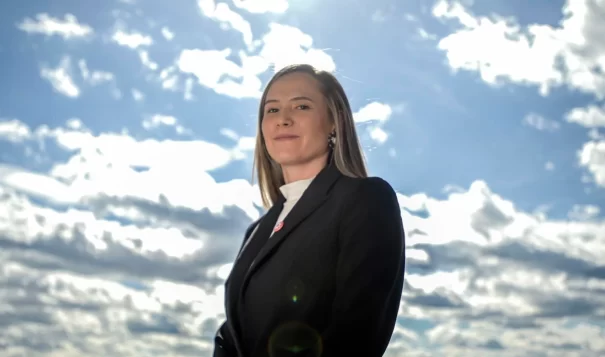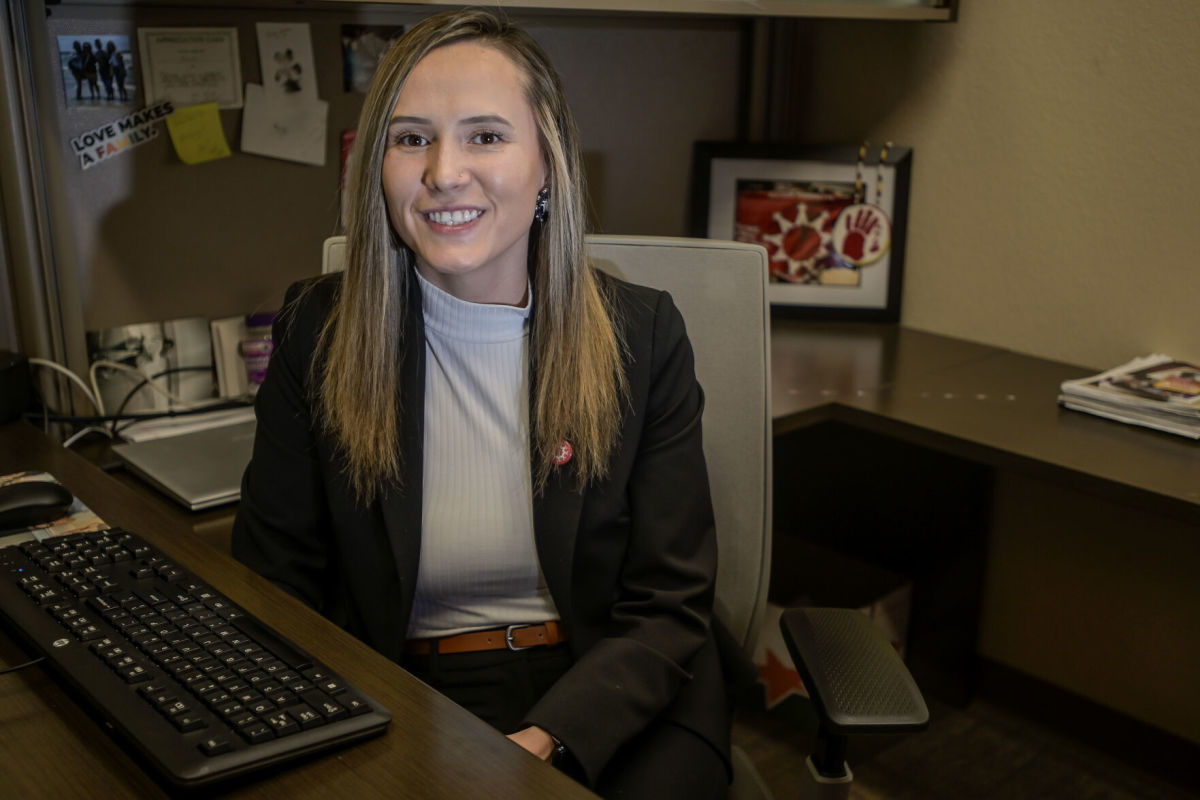News Based on facts, either observed and verified directly by the reporter, or reported and verified from knowledgeable sources.
MMIP cases in South Dakota remain high, new efforts hope to change that
 Allison Morrisette is the state of South Dakota's Missing and Murdered Indigenous Persons Coordinator. (Photo by Matt Gade, Rapid City Journal)
Allison Morrisette is the state of South Dakota's Missing and Murdered Indigenous Persons Coordinator. (Photo by Matt Gade, Rapid City Journal)
Initiatives from the South Dakota Attorney General’s Office aim at combating high rates of missing Indigenous people
Indigenous people account for roughly 60% of missing persons cases in South Dakota, which is still an undercount according to the Oglala Sioux Tribe Victim Services Department and Sisseton Wahpeton Oyate’s Domestic Violence & Sexual Assault Program. In response to the current crisis, the South Dakota Attorney General’s Office appointed a Missing and Murdered Indigenous Persons Coordinator to address the rising numbers of missing Indigenous people.
Over a year ago, the South Dakota Attorney General’s Office announced the creation of an MMIP advisory council, and in November 2022 announced the hiring of an MMIP Coordinator. The advisory council which is now called the stakeholders committee, was created by Attorney General Mark Vargoto to work in tandem with the MMIP Coordinator and provide guidance to the current Attorney General, Marty Jackley. Both initiatives aim to address the high number of missing Indigenous people across the state, according to a press release from the Attorney General’s Office.
“We’ve been made aware of the issues here in South Dakota for years now,” said Allison Morrisette, Oglala Lakota and the South Dakota MMIP Coordinator. “These are things that can’t be fixed overnight. The purpose of the [stakeholder’s committee] is to work with the community leaders, grassroots organizations and law enforcement to develop ideas that can hopefully be implemented statewide and help long-term with MMIP and the existing victims who need to be brought home to their families.”
Morrisette assumed her role as the MMIP Coordinator on Nov. 28, 2022, before the formation of the stakeholders committee. As the MMIP Coordinator, Morrisette’s job is to connect victim’s families with resources and support. The stakeholder’s committee is made up of regional advocates who meet twice a year. So far the committee has met two times, with a third meeting in the works.
Missing and murdered indigenous people cases in South Dakota
The map below displays MMIP case totals from 1963 to present, with larger hexagons indicating a higher number of cases in a given area. Hover over each hexagon for more details.
Initially, the effort to hire a MMIP Coordinator was slow-moving due the impeachment of Attorney General Jason Ravnsborg, and limited available funding from the state. Native Hope, a Chamberlain, South Dakota-based non-profit organization focused on uplifting Native voices and meeting community needs, stepped in with a three-year grant for the coordinator position, providing $85,000 towards Morrisette’s position each year.
In her previous role as a diversion case manager from the Pennington County Attorney General’s Office, Morrisette assisted participants in accessing mental health, rehabilitation, and educational resources. It wasn’t until she became a mother that she became interested in the MMIP coordinator position. When she applied for the position she was pregnant, and said she couldn’t help but wonder what would happen if her baby went missing one day.
“I was sitting there at my prior job thinking, ‘If my daughter went missing, I would want these laws and ideas to be implemented and I would want to know how to navigate the system,’” Morrisette said. “Obviously, the first thing you do is contact law enforcement, but what comes after that? I couldn’t answer that question. I wasn’t entirely sure how the process worked and I wanted to be able to be more involved and bring awareness to families.”
As of April 3, there were 79 missing Indigenous people listed in the South Dakota Missing Persons Clearinghouse and data shared from the Sisseton Wahpeton Oyate and Oglala Sioux Tribe’s victim services departments showed over 76 murdered Indigenous women missing in South Dakota since 1965. Despite accounting for roughly 10% of the South Dakota population, Indigenous people are consistently reported missing at much higher rates than other racial demographics, as shown by data from the Missing Persons Clearinghouse. There is no official state list of MMIP victims in South Dakota.
“Whether you look at the eastern side or the western side of the state, the rate of missing Indigenous people is so high,” Morrisette said. “This issue is very prevalent in South Dakota and there’s so many different aspects that go into that [high rate].”
Often, jurisdictional issues pose a major barrier in missing persons cases, according to Morrisette.
Officials from the Sisseton Wahpeton Oyate’s Victims Advocacy program are working to create new language in the tribal code establishing a community response plan for missing person cases and a memorandum of understanding — or partnership agreement — between tribal law enforcement, nearby sheriff’s departments, and local non-tribal law enforcement.
West of the Missouri River, the Oglala Sioux Tribe and Pennington County Sheriff’s Department have an MOU to provide services to each other in times of need. Most of the time this means working together on off-reservation missing persons cases.
“When we talk about human trafficking, people are amazed that it’s even an issue, especially when we talk about missing and murdered Indigenous people, often it’s overlooked,” said Tasha His Law, Sisseton Wahpeton Dakota and the executive director of Waciyanpi, an MMIP awareness and human trafficking prevention organization. “That’s one of our main reasons why we want this in tribal code so we can get MOUs for other counties and sheriffs to work with. Once it’s a non-Native [missing], they’re all for it, there’s coverage everywhere. When it comes to Natives there’s nothing.”
The Lake Traverse Reservation, home of the Sisseton Wahpeton Oyate has a considerable amount of “checkerboarded” land, meaning reservation land that was once all owned by the Native nation, is now broken up in parcels owned by both non-Native and tribal ownership. This makes missing persons cases incredibly complicated. If someone goes missing in Sisseton, the exact location they were last seen determines which law enforcement agency handles the case – whether it’s state, local, tribal or federal agencies.
“In one of our missing cases she lived in Sisseton Housing, which is tribal land, but [when] I went to the Sisseton Police Department, the chief of police said, ‘That’s not my jurisdiction,’” said Stacey Azure, Sisseton Wahpeton Dakota and an SWO victim’s services Case Manager and advocate.
Azure told him that the person was last seen in Sisseton to which the officer said that wasn’t his jurisdiction. Before that discussion, tribal police had told Azure that the case wasn’t in their jurisdiction either.
Of the four missing Sisseton Wahpeton Dakota individuals, Andrew “AJ” Lufkins and Dominic Alberts, were last seen in Sisseton. The other two, Avery Bissonette and Berlyn Heminger do not have a specific last-seen location.
“So long as the victim’s family reaches out or the law enforcement agency reaches out, we can try and help navigate those jurisdictional boundaries between tribal, state and federal agencies,” Morrisette said. “We don’t act on any investigative work, we just work to facilitate the family through this, or help offer resources to law enforcement agencies.”
Lily Mendoza, Cheyenne River Lakota, was appointed to the stakeholders committee because of her work with the Red Ribbon Skirt Society, her non-profit education and awareness group for Missing and Murdered Indigenous Women and their families. Her group works closely with victim families, so Mendoza brings that perspective to the stakeholders committee.
One thing the committee is working on is reconciling inconsistencies in data about missing Indigenous people in South Dakota, according to Morrisette. While the state’s missing person clearinghouse provides a list of currently missing people, it’s dependent on law enforcement agencies submitting information. This has created problems in cases like Delema Sits Poor’s. She was entered into the clearing house only two weeks ago, 50 years after she went missing, according to Tony Mangan, communications director for the Attorney General’s Office.

“At the state level we need a system for information on MMIP to see where law enforcement is at,” Mendoza said. “But it’s not about the data, it’s about the stories of the women and children. That’s what the families want. The families want someone to listen to them. A lot of families feel invisible, especially in urban communities.”
In the meantime, the Red Ribbon Skirt Society is launching a talking circle and support group for families.
In the future, Morrisette said she hopes for an expansion of her position. Right now she’s the only person working in the MMIP office covering the entire state of South Dakota.
“People will say, ‘Oh you’ve been doing this for over a year now,’ and they expect me to be an expert on everything,” Morrisette said. “But every day that I come into the office I’m learning something new, whether it’s from law enforcement, a grassroots organization, a victim’s family, or just someone interested in MMIP. If anyone has any ideas that they want to try and take statewide, feel free to get in touch with me, I’m always open for collaboration.”
Morrisette can be reached at 605-295-0003 or by email at Allison.Morrisette@state.sd.us.
Dateline:
RAPID CITY, S.D.
